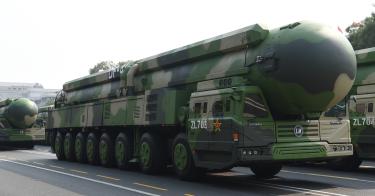Last month, experts discovered more than 100 new intercontinental-range ballistic missile (ICBM) silos under construction in China. This week, Matt Korda of the Federation of American Scientists uncovered a second site that could also house over 100 new silos. Together, the two discoveries suggest, in Korda’s words, “the largest expansion of China’s nuclear force ever.”
Historically, China’s strategy has been one of minimum deterrence, choosing to maintain the fewest nuclear weapons possible to deter nuclear attack. According to a 2020 Defense Department report, the number of nuclear warheads in Beijing’s arsenal is in the low-200s. In comparison, the United States deploys 1,550 nuclear weapons, as dictated by the New START agreement with Russia.
>>> Biden Administration’s Growing Disconnect on Nuclear Deterrence Priorities
Proponents of U.S. nuclear disarmament have tried to use this disparity in numbers to justify unilateral reductions in the U.S. nuclear stockpile. Even if China doubles its stockpile by the end of the decade, they note, it will still be dwarfed by that of the U.S.
These recent discoveries, however, appear to confirm warning after warning that China’s nuclear expansion must be taken seriously. Adm. Charles Richard, commander of U.S. Strategic Command, had cautioned that China should not be mistaken for a “lesser case.” Noting that China is becoming a nuclear peer to the U.S. and Russia, he has also stated that Beijing will likely more than double its nuclear arsenal by the end of the decade—possibly even tripling or quadrupling it.
Indeed, according to Korda, the number of new Chinese silos under construction exceeds the number operated by Russia and represents more than half those operated by the U.S. Perhaps more importantly, the discovery demonstrates China’s capacity to change its arsenal rapidly. The discovery of two massive construction projects in just a month leaves one wondering how else China might be expanding its nuclear forces.
These discoveries make it hard to continue arguing that China’s nuclear forces are insignificant compared to those of the United States. But numbers aside, China’s expansion should be analyzed against the purpose and structure of U.S. nuclear modernization efforts.
With the exception of two minor supplemental capabilities proposed by the 2018 Nuclear Posture Review, the U.S. nuclear modernization plan is simply to replace, on a one-for-one basis, the force agreed upon in 2010 under New START. But when that agreement was inked, the Pentagon’s 2010 Nuclear Posture Review considered Russia no longer to be an adversary, and China’s nuclear expansion wasn’t even on the radar screen.
Prudence would dictate that the overall force be modified to respond to a decade’s worth of geopolitical change. Yet for now, Washington is focused on merely modernizing our existing Cold War-era warheads and delivery platforms.
Replacing antiquated systems postured for a more benign security environment with 21st century technology should be a no-brainer. Yet disarmament hardliners are still debating the merits of even the modernization program. In addition to opposing the replacement of our superannuated weapons, they call for eliminating U.S. ICBMs altogether and cutting our overall nuclear force by one third.
>>> Getting Nuclear Posture Review Right Is Critical for U.S. Defense
As the U.S. now faces two peer competitors for the first time in its history, it is difficult to see how now is the right time to draw down our forces below what was needed to assure a safer world in the past. The nuclear threat to the U.S. is vastly greater now.
Thankfully, Congress is waking up to this point. Last week, the Democratic-led Senate Armed Services Committee agreed to a provision in its annual defense authorization bill expressing the sense of the Senate that the Ground Based Strategic Deterrent is necessary for U.S. national security. House Armed Services Committee Chairman Adam Smith also agreed that “we’ve got to keep [the Ground Based Strategic Deterrent program] alive.”
China’s rapidly expanding nuclear arsenal puts the United States’ modest nuclear modernization efforts into perspective. At the very least, proposals to cut current nuclear modernization programs should be put to rest. The U.S. would be better off debating ways we can adjust our capabilities to account for these changes. After all, our national security depends on maintaining a nuclear deterrent that addresses the world as it is—not the one we wish existed.
This piece originally appeared in The Hill on 07/28/21



